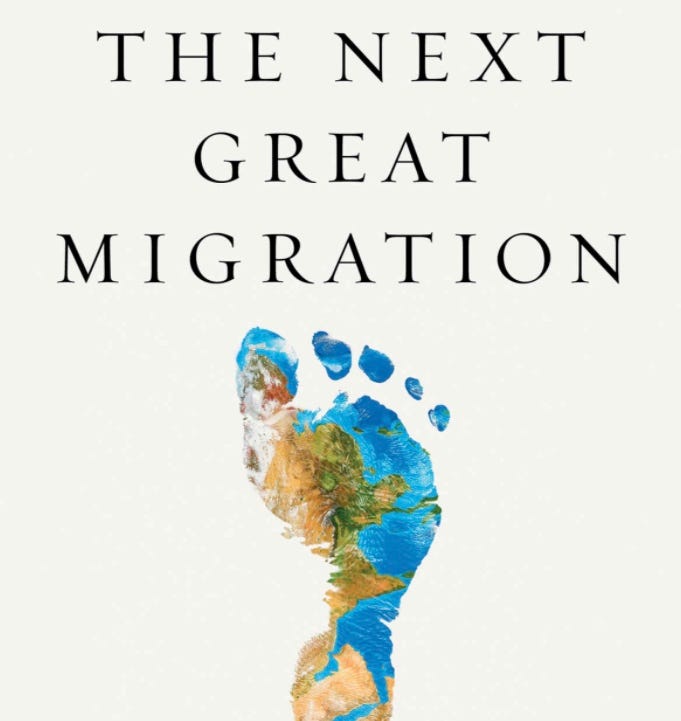Book review: The Next Great Migration, by Sonia Shah
Jack Hamilton analyzes the theory that we should welcome, not fear, the coming migration of some 200 million climate refugees
By John Maxwell Hamilton
(About the author: John Maxwell Hamilton, the Hopkins P. Breazeale Professor of Journalism at Louisiana State University, is a longtime journalist and author of Manipulating the Masses: Woodrow Wilson and the Birth of American Propaganda.)
WASHINGTON, D.C. (Callaway Climate Insights) — On the list of global security threats, migration is at or near the top. Even among those repelled by the Trump administration’s handling of immigrants, the conversation tends toward how best to deal with “the problem” of people streaming across borders around the world.
But now comes Sonia Shah with an important, deeply researched book that challenges that narrative. Instead of thinking of migration as a crisis, The Next Great Migration tells us to accept it as a natural process that, properly managed, offers a cornucopia of benefits.
Shah gets us to rethink human migration by making a larger point. Plants, animals, and people have been moving since time immemorial. It is a law of nature, not an anomaly.
“Over the past handful of years,” Shah writes, “as the climate’s grip on how we move has become increasingly apparent, new evidence of the centrality of migration in our biology and history has emerged.” [11]
Shah’s world is in constant motion. Some coral reefs move. With warmer weather, saplings take root farther up mountain slopes. Tracking devices record such amazing feats as a wolf in Trieste covering 1,000 kilometers of snow and frozen rivers, as well as steep mountains, over a period of four months to reach Austria.
And so it has been historically, regardless of the improbability of bridging geographic obstacles. Long before there were people in ships to transport them, American sweet potatoes made their way to Polynesia. Rodents in North America established themselves in South America before there was a land bridge.
A great deal of confirmation bias contributes to the dire picture we have of migration. Consider the mass deaths of poor lemmings, which have been used to justify the idea that mother nature gives us a way to deal with declining resources: mass suicide. In fact, the furry creatures burrow under the snow. For a long time no one bothered to look. Nevertheless, a highly staged documentary on fictional lemming suicide won an Academy Award in1959.
Animals facing shortages of food have for centuries moved, not killed themselves. The first migrations may have been occasioned by people following them. When animals can’t move to find food, say when they live on an island, they die of starvation.
Yet, we are taught to think of the world as a place of silos in which people, animals, and plants should stay put as they supposedly were intended to do.
All manner of cockeyed data have been trotted out to confirm the view that “the other” is the enemy. The German Interior Ministry’s announcement of an immigrant crime wave several years ago was Orwellian in its reasoning. It reported 402,000 “excess” crimes since the latest wave of immigrants had been admitted. The definition of “crime” was the entrance into the country of 402,000 individuals who did not have prior permission. The “crime wave” became an international news story.
Or consider the zebra mussel. It is maligned for killing off native clams. But the clams, Shan notes, were already imperiled, and the zebra mussels are highly efficient water purifiers. “If zebra mussels were native,” a botanist said, “there’s every reason to expect they would be hailed as environmental heroes.” [p. 246]
Further to that point, biologists have found that only one-tenth of one percent of new species can establish themselves in a new environment and only a tenth of those — one percent overall — pose a risk to existing species.
When it comes to human migration, new arrivals put pressure on national budgets. But migrants tend to be resilient, fit, and determined, all qualities we want in our citizens. Too often, only the costs of migration are calculated, and the benefits ignored.
Similarly, the opponents of migration like to think only in terms of racial differences. In fact, migration has made people remarkably similar. “A paltry 0.1% of the sequence of the 3 billion nucleotides strung together on our DNA differed from anyone person to the next.” [p. 206]
Shad, a journalist, received support for this book from the Pulitzer Center on Crisis Reporting, a point worth mentioning because the center has sponsored a great deal of significant international journalism like this. If the book has a defect, it lies in its poorly drawn index that has no entries for zebra mussels or sweet potatoes.
Perhaps some readers will see Pollyanna in these pages. But Shah’s approach is essential in making the case against knee-jerk Cassandraism. She does not shy away from the challenges that lie ahead as a result of climate change.
By midcentury we may have as many as 200 million climate refugees. Xenophobia is not the solution to managing this movement of people. Walls won’t keep desperate people out, although in the case of the U.S.-Mexico border the walls “endanger 90 species that live on either side of it.” [p. 291]
Instead, we need to create physical and legal pathways that allow for safe and organized migration, and we need to develop social infrastructure to help these newcomers realize their potential. Healthy societies have a much better chance of working out solutions than those riven by fear and alienation.

